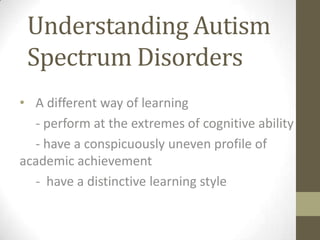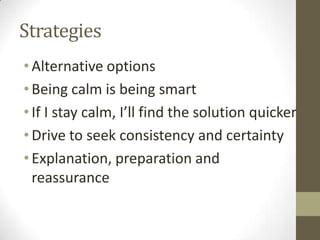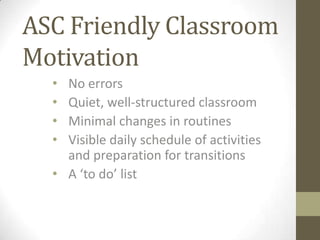Understanding autism spectrum disorders
Download as pptx, pdf0 likes253 views
Autism spectrum disorders involve a different way of learning, with individuals performing at extremes of cognitive ability and having uneven academic profiles and distinctive learning styles. To help those with ASDs, classrooms should provide alternative options, consistency, explanations and preparation for changes. An autism-friendly classroom is highly structured, organized and quiet, with a visible daily schedule, activities sequenced with details, and minimal changes to routines.
1 of 4
Download to read offline




Ad
Recommended
Psychology Powerpoint
Psychology PowerpointZoeFeldmann
╠²
Clinical psychologists diagnose and treat mental, emotional, and behavioral disorders through counseling and therapy. They work one-on-one and in groups in a variety of settings like offices, schools, hospitals, and clinics. Successful psychologists are emotionally stable, patient, compassionate, and able to work well with others. They typically need a master's degree or doctorate in psychology, which can be obtained after earning a bachelor's degree and taking relevant psychology courses. Salaries range from $52,000 to over $100,000 depending on experience and location.Qualities of good science teacher
Qualities of good science teacherfarwakhalil1
╠²
The document outlines several key qualities of a good science teacher:
1. They are sincerely committed to their profession and inspire excellence in both their own work and their students'.
2. They are studious, constantly learning to stay up to date in their field, and avid readers across many sources of knowledge.
3. They are able to clearly communicate ideas through organized blackboard work and explain concepts with ease.
4. They treat all students impartially without bias and create a cooperative learning environment.
5. They demonstrate leadership through discipline and inspiration, channeling student energy towards constructive goals.Educational Psychology
Educational Psychologyindrani kalita
╠²
Educational psychology is an applied branch of psychology that studies human behavior in educational contexts, focusing on the development and learning processes of children. It encompasses various aspects including individual differences, learning methods, and the influence of heredity and environment, aiding teachers in understanding and improving teaching methodologies. This discipline also provides guidance for mental health and educational performance assessment, helping in curriculum development and addressing classroom challenges.Health EDUCATION
Health EDUCATIONSozil Penaranda
╠²
This document discusses health education for secondary school students. It covers the nature of adolescent development, including cognitive, social, emotional and physical changes. It also discusses the importance of understanding development and potential difficulties students may face. The psychological needs of adolescents are outlined as love, power, freedom and fun. Finally, several learning theories are introduced, including behaviorist, cognitive, social, psychodynamic and humanistic approaches.From the philosophical to the practical
From the philosophical to the practicalMatt Scully
╠²
This document discusses creating an engaging learning environment for students. It suggests:
1) Focusing on the child by getting to know each student, preparing the classroom space to welcome them, and establishing routines and traditions.
2) Treating the first month as diagnostic to establish foundations for the year by familiarizing yourself with the curriculum and planning initial lessons.
3) Taking care of yourself as a teacher by prioritizing your well-being, areas of focus, support needs, and opportunities for reflection and growth.4share step5
4share step5Rema Menon
╠²
This document summarizes various theories related to thinking skills and learning styles:
- Roger Sperry's research on left brain and right brain functions showed that each side controls different types of thinking. The right brain handles creative tasks while the left brain handles logical tasks.
- Howard Gardner identified nine multiple intelligences including linguistic, logical-mathematical, spatial, bodily-kinesthetic, musical, interpersonal, intrapersonal, naturalist, and existential. Teachers should implement various teaching strategies and activities to engage students with different intelligences.
- Dunn and Dunn's learning style model considers environmental, emotional, sociological, physical, and psychological elements that influence how students learn. Students have uniqueTypes of Scientific Method
Types of Scientific MethodSahin Sahari
╠²
The document outlines three types of research methods in education: exploratory, explanatory/causal, and descriptive. Exploratory research is a preliminary investigation aimed at gaining insights into a poorly defined problem, explanatory research seeks to understand the 'why' behind phenomena, and descriptive research focuses on detailing the characteristics of populations or phenomena. Each method serves a unique purpose, with exploratory investigating observations, explanatory explaining reasons, and descriptive detailing subjects.How is the Quality of Mid-day Meals Maintained
How is the Quality of Mid-day Meals MaintainedAkshaya Patra Foundation
╠²
The document discusses the importance of maintaining quality and nutritional standards in the Mid-Day Meal Program in India, which serves over 100 million children. It highlights guidelines for calorie and protein content, the necessity of hygiene practices, and the role of organizations like the Akshaya Patra Foundation in implementing food safety measures. The foundation's practices include staff training, quality checks, and tailored menus to meet regional nutritional needs, emphasizing the significant impact of the program on combating malnutrition.N20151015 al 21 s├Łnodo
N20151015 al 21 s├ŁnodoRsm San Mart├Łn
╠²
The document discusses the ongoing synod of Catholic bishops focusing on family issues, showing significant differences in opinions about how the Church should address contemporary societal challenges, particularly in relation to divorce and inclusivity. Various bishops express the need for language that is more accessible and less legalistic while emphasizing God's mercy and understanding. Key themes include the pastoral approach to those affected by divorce and the need for reflection on the relationship between mercy and justice within the Church's teachings.┬┐C├│mo son los robos en negocios?Securitas Direct Espa├▒a
╠²
Este documento presenta datos sobre los robos en negocios en Espa├▒a y en el mundo. Indica que los comercios abiertos al p├║blico son los m├Īs propensos a los intentos de robo, seguidos de las naves industriales y las oficinas. Los meses con m├Īs robos son noviembre y diciembre, e indica que la mayor├Ła de los hurtos se producen por la noche. Finalmente, proporciona datos sobre las comunidades aut├│nomas con m├Īs intentos de robo en negocios, siendo Madrid, Andaluc├Ła, Catalu├▒a y la ComBolet├Łn junio julioRsm San Mart├Łn
╠²
El documento resume las celebraciones de la Orden de Predicadores por su 800 aniversario en Per├║, incluyendo la condecoraci├│n de la Orden por la Universidad Nacional Mayor de San Marcos, y las diversas actividades realizadas por los monasterios dominicos de Lima, Cusco y Arequipa en junio, como conferencias, misas y compartir fraternal.Producing_Cover Letter
Producing_Cover LetterShawnna Johnson
╠²
Shawnna Johnson is applying for a producing position. She has over eight years of experience in digital media production across various formats. She showcases her skills in her online reel and resume, demonstrating her abilities in areas such as scheduling, budgeting, and managing projects from conception to completion. Johnson highlights two past producing roles where she negotiated sponsorships, delivered projects under budget and on time, and took initiatives to improve final products. She hopes her qualifications are a good fit for the open position.Oct 25 CAPHC Concurrent Symposium - Hope Blooms
Oct 25 CAPHC Concurrent Symposium - Hope BloomsGlenna Gosewich
╠²
The document discusses Hope Blooms, a social enterprise that teaches life skills to at-risk youth through gardening and farming. It mentions that Hope Blooms made a deal with Loblaw, a major grocery chain, and that one Hope Blooms graduate is taking the life lessons learned to college. The overall message is about the positive impact of Hope Blooms' program on youth development and education.Postal de navidadmmonroy99
╠²
Este documento contiene tres deseos navide├▒os. El primero desea que la magia, la sonrisa, los ojos y la felicidad de la persona sean lo mejor de sus fiestas. El segundo bromea que Pap├Ī Noel podr├Ła llevarse a la persona y dejar sin regalos a los dem├Īs. El tercero, de manera humor├Łstica, lista varios adjetivos para describir un regalo, pero aclara que desafortunadamente no puede entregarlo a trav├®s de la pantalla. Se les desea a todos una Feliz Navidad.Oct 24 CAPHC Annual General Meeting - Part 2
Oct 24 CAPHC Annual General Meeting - Part 2Glenna Gosewich
╠²
1. The Canadian Association of Paediatric Health Centres (CAPHC) held its 2015 Annual General Meeting on October 20, 2015 in Quebec City, Quebec. Marilyn Monk, CAPHC Chair, welcomed members and declared the meeting legally constituted upon motions made.
2. The minutes from the 2014 AGM and the 2014-2015 auditors report were presented and approved. The 2015-2016 budget projected a balanced budget through funding from members, conferences, sponsors and partners.
3. Elections were held for the 2015-2016 CAPHC Board of Directors and Slate of Officers. Recognition awards were also given to outgoing Board members. The meeting was then adjourned upon motion.MACROECONOMICS-CH14
MACROECONOMICS-CH14kkjjkevin03
╠²
This chapter discusses debates around stabilization policy. It considers whether policy should be active or passive in response to economic fluctuations, and whether policy should be set by rule or allow discretion. Arguments for active policy include reducing economic hardship, while arguments for passive policy cite lags in policy effects. Rules are argued to increase credibility and avoid time inconsistency, while discretion allows flexibility. Overall there is no clear consensus from history on the best approach.Efectos psicol├│gicos de un roboSecuritas Direct Espa├▒a
╠²
Una encuesta revela que el 94% de las v├Łctimas de un robo en su hogar teme volver a ser asaltado, y el 67% experimenta da├▒os emocionales. Adem├Īs, el 52% de los encuestados ya no se siente seguro en casa y el 69% tiene problemas para dormir tras el incidente. La inseguridad afecta a los ni├▒os, con un 30% de las familias que no duerme en casa la noche siguiente al robo.Understanding Free/Open Source Software (FOSS) and the Benefit to E-Commerce
Understanding Free/Open Source Software (FOSS) and the Benefit to E-CommerceIr. Dr. R.Badlishah Ahmad
╠²
The document discusses the advantages of free and open-source software (FOSS) in e-commerce, highlighting its cost-effectiveness, flexibility, and the avoidance of vendor lock-in. It contrasts proprietary software with open-source alternatives, emphasizing the freedoms and potential for modification that open-source offers. Additionally, the document outlines ten benefits of using open-source software for businesses, including better responsiveness to company needs and the quality of community-developed code.More Related Content
Viewers also liked (13)
How is the Quality of Mid-day Meals Maintained
How is the Quality of Mid-day Meals MaintainedAkshaya Patra Foundation
╠²
The document discusses the importance of maintaining quality and nutritional standards in the Mid-Day Meal Program in India, which serves over 100 million children. It highlights guidelines for calorie and protein content, the necessity of hygiene practices, and the role of organizations like the Akshaya Patra Foundation in implementing food safety measures. The foundation's practices include staff training, quality checks, and tailored menus to meet regional nutritional needs, emphasizing the significant impact of the program on combating malnutrition.N20151015 al 21 s├Łnodo
N20151015 al 21 s├ŁnodoRsm San Mart├Łn
╠²
The document discusses the ongoing synod of Catholic bishops focusing on family issues, showing significant differences in opinions about how the Church should address contemporary societal challenges, particularly in relation to divorce and inclusivity. Various bishops express the need for language that is more accessible and less legalistic while emphasizing God's mercy and understanding. Key themes include the pastoral approach to those affected by divorce and the need for reflection on the relationship between mercy and justice within the Church's teachings.┬┐C├│mo son los robos en negocios?Securitas Direct Espa├▒a
╠²
Este documento presenta datos sobre los robos en negocios en Espa├▒a y en el mundo. Indica que los comercios abiertos al p├║blico son los m├Īs propensos a los intentos de robo, seguidos de las naves industriales y las oficinas. Los meses con m├Īs robos son noviembre y diciembre, e indica que la mayor├Ła de los hurtos se producen por la noche. Finalmente, proporciona datos sobre las comunidades aut├│nomas con m├Īs intentos de robo en negocios, siendo Madrid, Andaluc├Ła, Catalu├▒a y la ComBolet├Łn junio julioRsm San Mart├Łn
╠²
El documento resume las celebraciones de la Orden de Predicadores por su 800 aniversario en Per├║, incluyendo la condecoraci├│n de la Orden por la Universidad Nacional Mayor de San Marcos, y las diversas actividades realizadas por los monasterios dominicos de Lima, Cusco y Arequipa en junio, como conferencias, misas y compartir fraternal.Producing_Cover Letter
Producing_Cover LetterShawnna Johnson
╠²
Shawnna Johnson is applying for a producing position. She has over eight years of experience in digital media production across various formats. She showcases her skills in her online reel and resume, demonstrating her abilities in areas such as scheduling, budgeting, and managing projects from conception to completion. Johnson highlights two past producing roles where she negotiated sponsorships, delivered projects under budget and on time, and took initiatives to improve final products. She hopes her qualifications are a good fit for the open position.Oct 25 CAPHC Concurrent Symposium - Hope Blooms
Oct 25 CAPHC Concurrent Symposium - Hope BloomsGlenna Gosewich
╠²
The document discusses Hope Blooms, a social enterprise that teaches life skills to at-risk youth through gardening and farming. It mentions that Hope Blooms made a deal with Loblaw, a major grocery chain, and that one Hope Blooms graduate is taking the life lessons learned to college. The overall message is about the positive impact of Hope Blooms' program on youth development and education.Postal de navidadmmonroy99
╠²
Este documento contiene tres deseos navide├▒os. El primero desea que la magia, la sonrisa, los ojos y la felicidad de la persona sean lo mejor de sus fiestas. El segundo bromea que Pap├Ī Noel podr├Ła llevarse a la persona y dejar sin regalos a los dem├Īs. El tercero, de manera humor├Łstica, lista varios adjetivos para describir un regalo, pero aclara que desafortunadamente no puede entregarlo a trav├®s de la pantalla. Se les desea a todos una Feliz Navidad.Oct 24 CAPHC Annual General Meeting - Part 2
Oct 24 CAPHC Annual General Meeting - Part 2Glenna Gosewich
╠²
1. The Canadian Association of Paediatric Health Centres (CAPHC) held its 2015 Annual General Meeting on October 20, 2015 in Quebec City, Quebec. Marilyn Monk, CAPHC Chair, welcomed members and declared the meeting legally constituted upon motions made.
2. The minutes from the 2014 AGM and the 2014-2015 auditors report were presented and approved. The 2015-2016 budget projected a balanced budget through funding from members, conferences, sponsors and partners.
3. Elections were held for the 2015-2016 CAPHC Board of Directors and Slate of Officers. Recognition awards were also given to outgoing Board members. The meeting was then adjourned upon motion.MACROECONOMICS-CH14
MACROECONOMICS-CH14kkjjkevin03
╠²
This chapter discusses debates around stabilization policy. It considers whether policy should be active or passive in response to economic fluctuations, and whether policy should be set by rule or allow discretion. Arguments for active policy include reducing economic hardship, while arguments for passive policy cite lags in policy effects. Rules are argued to increase credibility and avoid time inconsistency, while discretion allows flexibility. Overall there is no clear consensus from history on the best approach.Efectos psicol├│gicos de un roboSecuritas Direct Espa├▒a
╠²
Una encuesta revela que el 94% de las v├Łctimas de un robo en su hogar teme volver a ser asaltado, y el 67% experimenta da├▒os emocionales. Adem├Īs, el 52% de los encuestados ya no se siente seguro en casa y el 69% tiene problemas para dormir tras el incidente. La inseguridad afecta a los ni├▒os, con un 30% de las familias que no duerme en casa la noche siguiente al robo.Understanding Free/Open Source Software (FOSS) and the Benefit to E-Commerce
Understanding Free/Open Source Software (FOSS) and the Benefit to E-CommerceIr. Dr. R.Badlishah Ahmad
╠²
The document discusses the advantages of free and open-source software (FOSS) in e-commerce, highlighting its cost-effectiveness, flexibility, and the avoidance of vendor lock-in. It contrasts proprietary software with open-source alternatives, emphasizing the freedoms and potential for modification that open-source offers. Additionally, the document outlines ten benefits of using open-source software for businesses, including better responsiveness to company needs and the quality of community-developed code.Understanding Free/Open Source Software (FOSS) and the Benefit to E-Commerce
Understanding Free/Open Source Software (FOSS) and the Benefit to E-CommerceIr. Dr. R.Badlishah Ahmad
╠²
Understanding autism spectrum disorders
- 1. Understanding Autism Spectrum Disorders ŌĆó A different way of learning - perform at the extremes of cognitive ability - have a conspicuously uneven profile of academic achievement - have a distinctive learning style
- 2. Strategies ŌĆóAlternative options ŌĆóBeing calm is being smart ŌĆóIf I stay calm, IŌĆÖll find the solution quicker ŌĆóDrive to seek consistency and certainty ŌĆóExplanation, preparation and reassurance
- 3. ASC Friendly Classroom Motivation ŌĆó No errors ŌĆó Quiet, well-structured classroom ŌĆó Minimal changes in routines ŌĆó Visible daily schedule of activities and preparation for transitions ŌĆó A ŌĆśto doŌĆÖ list
- 4. Organised and Structured ŌĆóSequence of activities ŌĆóWhat to do ŌĆóWho with ŌĆóDuration (completed, music, clock) ŌĆóWhat next
